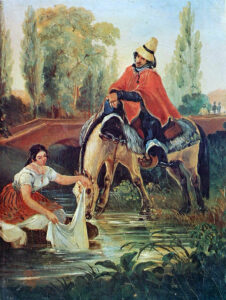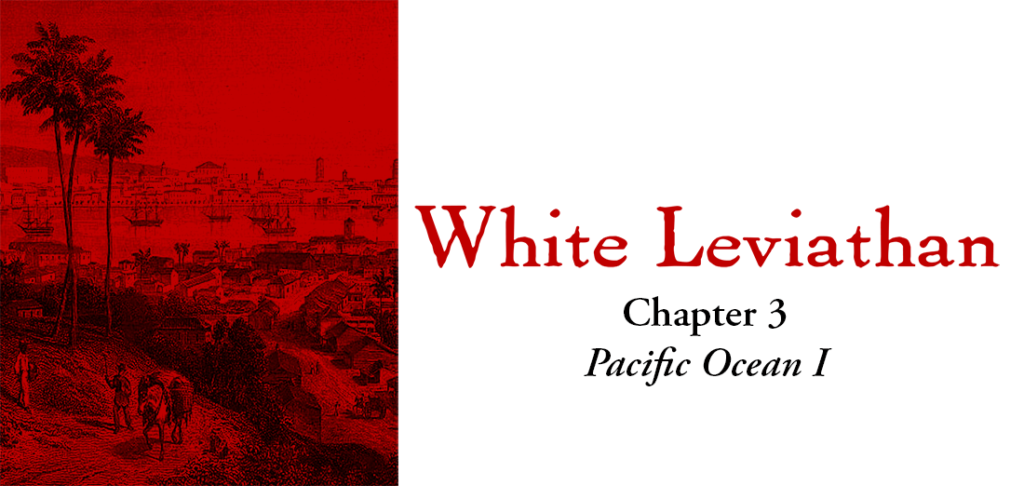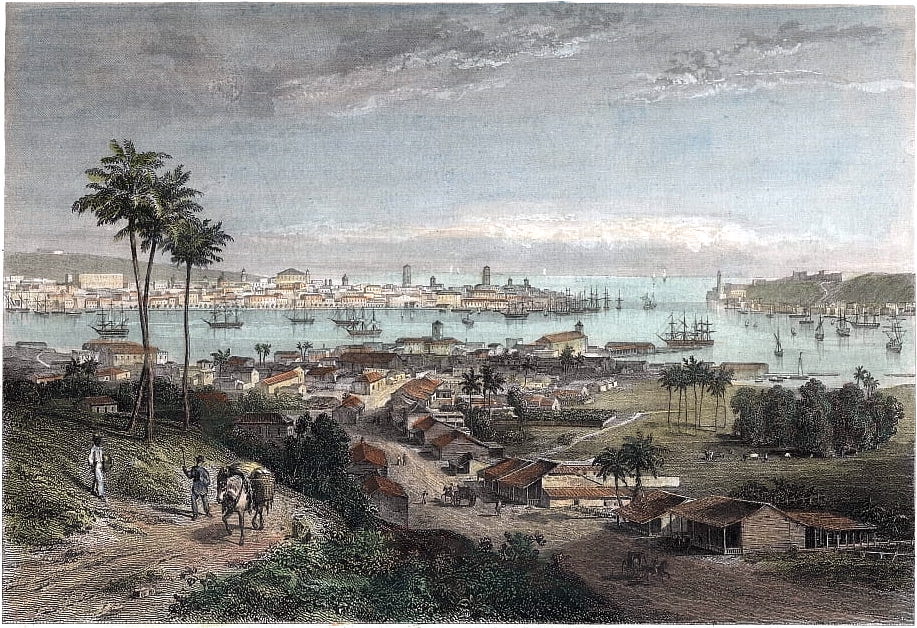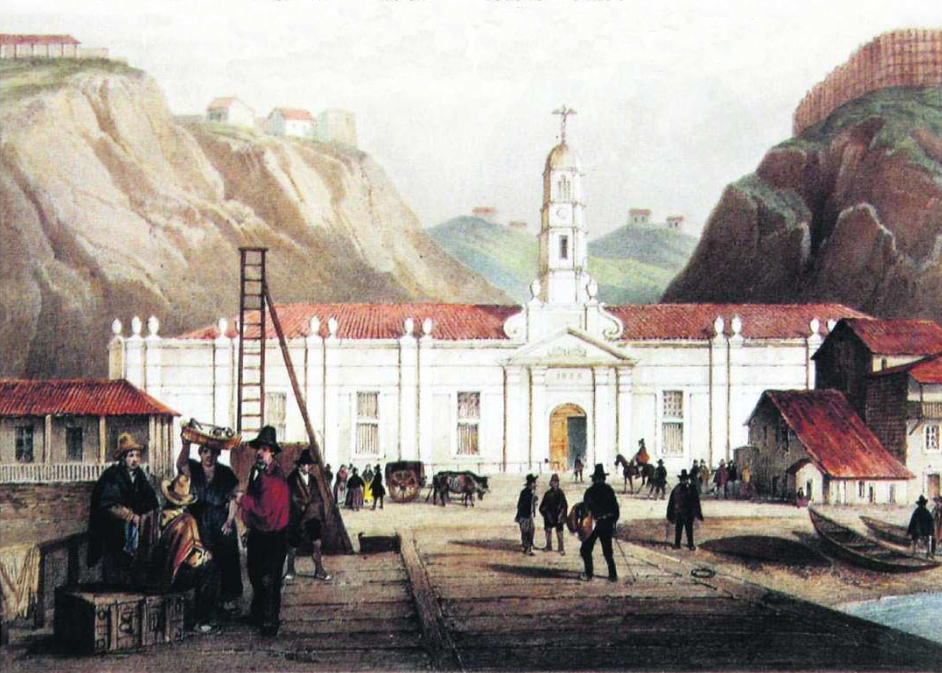Pacific Ocean I: Valparaíso
- At June 12, 2022
- By Great Quail
- In White Leviathan
 0
0
At last we rounded that stormy Cape,
Fair nights and pleasant days.
The next place that we anchor
Will be Valparaíso Bay.
For there the girls will welcome you,
I solemnly declare,
For they’re not much like the Liverpool girls
with their curls and glossy hair.
They’ll invite the Yankee sailors to come on shore and spree.
And when your money it is gone, they’ll give it back to thee.
And when your money it is gone, they’ll not on you impose,
For they’re not much like those Liverpool girls who’ll go and pawn your clothes.
Farewell to Valparaíso, just for a little while,
Likewise to all the others of those fair Pacific isles.
And when we get home again, we’ll sit and sing this song.
God bless those little Spanish girls we left around Cape Horn.
—“The Girls Around Cape Horn,” Traditional
4) Valparaíso
Chile, March 10-18, 1845
A) Background: Valparaíso
Commonly called “Vallipo” by sailors, Valparaíso is located 75 miles southwest of Santiago. One of the largest Pacific ports in the Americas, Valparaíso is home to the Chilean Navy, and represents an important way-station for American whalers and English merchants. Indeed, Valparaíso supports a thriving British community, known as la colonia Britanica. They congregate in their own neighborhoods located on Cerro Alegre and Cerro Concepción. Valparaíso is served by a newspaper established in 1827, El Mercurio de Valparaíso. The weather is fair, and March temperatures range in the mid-60s.
Valparaíso, Chile, 1840. By Edward Willmann
Vale of Paradise
Valparaíso is Spanish for “Vale of Paradise,” and most sailors agree the name is well-founded. With its bright colors, terracotta roofs, and wide-open plazas, Vallipo evokes the charm of the Mediterranean, especially when the sun is shining and the weather is mild. A city of hills, Vallipo sprawls over forty unique cerros, its labyrinthine streets crowded with gayly-painted houses that scale the terraces along the harbor. Many are built directly into the hills, supported by wooden stilts, or featuring more stories in front than back. Closer to the harbor, thatch and painted adobe give way to grand palaces in Spanish and Italianate style. Churches abound, and rectangular belltowers push heavenward in a potent reminder of the nation’s Catholic faith.
As might be expected from such a hilly city, the streets are narrow and crowded, connected by twisting staircases and winding switchbacks. Most streets are too narrow for carriages, and donkeys are still the preferred method of transporting goods. The flow of commerce is always oriented towards the water. Hundreds of ships and boats crowd the harbor, half of them British. The shore teems with fish markets, fruit vendors, outfitters, buskers, beggars, and opportunists of all stripes. Presiding over this merry disorder is the white customs house, its clocktower lifting a golden cross above the Plaza de la Aduana.
Aduana de Valparaíso, by Alphonse Bichebois, 1836-37
| A Sailor’s Paradise Yankee sailors regard Vallipo as a near utopia. The weather is pleasant, the natives hospitable, and the women—? The “Spanish ladies” of Valparaíso have been immortalized in dozens of sea shanties, their warmth and generosity contrasted with the cold-hearted hustlers of New York and Liverpool. While the reality is less ideal, and sailors certainly get robbed, swindled, and “poxxed” in Vallipo, the moral climate is generally more permissive in Spanish ports, and prostitution less expensive. There’s also the language barrier. Not only does this contribute an exotic appeal, it prevents the sailors from fully understanding the women’s spirited opinions and complaints! |
Exchange Rates
For Keepers who’d like extra authenticity, the main unit of currency in Chile is the silver peso. There are 8 silver reales in 1 peso, or 100 copper centavos. There’s also the escudo, a gold coin worth 2 pesos. In 1845, one Chilean peso is worth 2.3 American dollars.
B) Law and Order
Despite its liberal reputation with sailors, Valparaíso is no lawless den of iniquity—there’s too much commerce passing through the port for officials to condone unfettered licentiousness! The town watch maintains an appreciable presence, and cloaked solders are posted throughout Vallipo’s twisting streets. The sizable “calibouse,” or jail, is located on a hill near the town center; and as one might imagine, conditions are fairly wretched. Public disturbances are usually addressed by arresting all participants and throwing them in jail until somebody bails them out.
Valparaíso Soldier
Age: 16-40, Nationality: Chilean, Birthplace: Various
| STR 70 | CON 60 | SIZ 70 | DEX 60 | INT 50 |
| APP 50 | POW 60 | EDU 40 | SAN 60 | HP 13 |
| DB: +1D4 | Build: 1 | Move: 8 | MP: 12 | Luck: 60 |
Combat
| Brawl | 80% (40/16), damage 1D3+1D4 |
| M1752 Musket | 65% (33/13), damage 1D12+4 |
| Truncheon | 70% (35/14) |
| Dodge | 60% (30/12) |
Skills
Climb 60%, Credit Rating 15%, First Aid 30%, Intimidate 70%, Jump 40%, Law 50%, Leadership 35%, Listen 75%, Locksmith 25%, Persuade 50%, Psychology 40%, Read Lips 20%, Renown 5%, Spot Hidden 65%, Stealth 50%.
Languages: Spanish native; Portuguese 10%, English 5%
Description
Lacking a standardized police force, Valparaíso’s watch consists of soldiers from La Guardia Nacional, a state militia composed of semi-professional soldiers conscripted from the ranks of eligible Chilean males. As they must pay for their own uniforms—trousers, blue jackets and shakos—individual guardsmen range from poorly-dressed grifters to immaculate law-and-order types. When the need for firearms arises, the men have access to antiquated Model 1752 “patilla Miquelet” muskets dating from the Colonial period.
C) Port of Call
The Quiddity arrives in Valparaíso the afternoon of March 10, carried on a mild breeze and surrounded by a halo of seagulls. The sun shines from a clear blue sky, dazzling the eye with Valparaíso’s confusion of painted adobe and terracotta rooftops. The cries of Spanish estibadores drift across the water, mingling with the creaking of a thousand masts. The air is scented with cocoa and coffee, and the sound of tolling church bells floats from the hills like soft, bronze petals.
The Quiddity drops anchor between a Boston merchantman and a whaler from Mystic. Joab assembles the crew on deck, gazing over their faces with mock solemnity as they shift their restless feet and steal glances at the welcoming port. Once the men have settled down, he begins—“Shipmates, hear me. We’ve been four months at sea. We’ve suffered raging storms and devilish heat. We rounded the Horn, only to be rudely accosted by mutinous blackguards! I think it’s time we repaired our floating home; and repaired our bodies and souls as well.” Joab pauses dramatically; then a rare smile reveals his stern pose as playful theatrics: “The Quiddity shall remain in Vallipo for eight full days—we wouldn’t want to slight the Creator with ungodly haste, would we?”
Joab’s announcement is greeted like the Good News of Christ’s glorious Resurrection. Peter Veidt cries, “Three cheers for th’ Cap’n!” After the round of huzzahs! dies down, Mr. Pynchon explains the details: Repairs must be made from stem to stern. A new rudder must be purchased and shipped, the splintered anchor deck repaired, and anything lost in the December squall must be replaced. Fresh water and provisions must be purchased as well. The work will be difficult, but there’s a generous amount of liberty to ease the burden.
Schedule: Valparaíso, March 10-18
The new schedule takes effect immediately. Today is devoted to giving the Quiddity a complete cleaning, but for the remainder of the week, the men will be rotated through liberty by watches. Starting at dawn tomorrow, Mr. Coffin’s starboard watch is granted two days of liberty (March 11-12) while Mr. Whipple’s larboard watch takes in provisions and carries out repairs. After that, the positions are reversed, but the larboard watch gets three days of shore leave (March 13-15) to compensate for the delay, and for taking the lion’s share of the early work. This will be followed by two days of general liberty for all on March 16. Every man is expected to return to the ship by sundown March 17, and the Quiddity sails the morning of March 18. It’s a generous schedule, and normally officers might worry about desertions—especially after the run of bad luck! But Joab knows his Binding Oath ties the men to the ship more firmly than bonds of duty, loyalty, or promised riches.
Player Characters
Mr. Coffin, Beckett, and Redburn are bound to the watch rotation. Dixon, Morgan, and Quakaloo may govern themselves—as long as they perform their duties, they may take their liberty at any time. Of course, Dr. Lowell and Rachel are free to come and go as they please. However, Rachel is six months pregnant. While this hasn’t impacted her mobility, she’s begun to develop heartburn, backaches, and occasional spells of dizziness.
D) Work
Mr. Pynchon manages the Day 1 cleaning operation, and he’s a stickler for fresh paint and polished brass! Also, the forecastle must be thoroughly scrubbed—“No pigsties in the Quiddity, men.” Mr. Coffin is dispatched to Vallipo to acquire major items such as masts, sails, and whaleboats. He’s allowed to take two sailors as assistants. Mr. Whipple is placed in charge of provisions, and soon merchants are rowing up to the Quiddity with fresh fruits, cocoa-nuts, and nets crammed with bananas and plantains. Casks of water are brought onboard, along with a dozen chickens and four hogs squealing from a wooden crate. Three crates of pisco, two boxes of cigars, and a sack of cocoa are purchased from a Colombian named Gabriel Mesa, a cheerful man with a pet spider monkey named Cisco. Needless to say, these latter items are reserved for the officers and steerage gang!
| Pisco & Cigars A Chilean specialty, pisco is a fiery liqueur made from fermented Quebranta grapes, and is occasionally mixed with lemon juice, sugar and egg whites. Between 30-45% alcohol, it’s known for inflicting a deadly hangover. Cigars are another South American staple much loved by sailors, and are smoked by Spanish men and women alike, who carry small tinder boxes as part of their personal accoutrements. |
Managing the Repairs
Cleaning, repairing, and provisioning needn’t be roleplayed, and may be narrated solely for color. Mr. Coffin should toss a few dice to assess his mercantile skills—perhaps Accounting, Appraise, Charm, Credit Rating, and Fast Talk. There are no consequences for failures—well, maybe a tongue-lashing from Joab along the lines of, “I thought Nantucketers were spendthrifts, man! Thou just lost the profits from our first whale!”—but successes are rewarded with check marks for future Development Phases. Meanwhile back on ship, the Keeper may allow another round of general “repair rolls” to assess each character’s general progress.
E) News of the World
Valparaíso offers the Quiddity’s crew the chance to catch up on world events. First and foremost, the United States has a new President! Democrat James K. Polk defeated Whig Henry Clay, placing America on an aggressive path of westward expansion. In fact, Congress just approved the annexation of the Republic of Texas, and on March 3 Florida was admitted to the Union, bringing the total states to twenty-seven. The news about Texas saddens Virgil Caine—“Texas’ll be after Florida, mark my words. No more independence.” Polk’s victory is unwelcome news to la colonia Britanica, who are concerned that Britain and the U.S. may come to blows over Oregon.
In local news, President Juan Jose Flores of Ecuador was deposed in a revolution on March 6, placing Vincente Ramon Roca in power. Chileans shake their heads: Ecuador is a troubled country, but thankfully they’re Peru’s problem. Meanwhile, the French continue their war to maintain control of Tahiti and spread their influence to the Leeward Islands. Although Britain remains officially neutral, English sympathy lies with the exiled Queen Pomare, and they continue to patrol the Society Islands as a bulwark against French expansionism.
The Manuxet Horror
Having made haste to reach Vallipo, the Quiddity arrives before news of the Manuxet explosion, which reaches port the afternoon of March 11. The event is quickly dubbed “the Manuxet Horror,” and rumors spread as fast as flames across the Golconda—it was British sabotage, it was Mexican sabotage, it was an accident caused by a midshipman smoking marijuana in the powder room, it was a vicious mutiny…
F) Resolving the Mutiny
Another job that falls to Mr. Coffin is reporting the Manuxet mutiny to the American consulate. That office is currently occupied by Mr. Eben Ritchie Dorr, a non-nonsense diplomat from Massachusetts. Having recently changed posts from Argentina to Chile, Dorr has a firm grasp of Patagonian politics, and he’s already had his fill of whaler’s complaints—“More trouble than they’re worth, usually.”
However, the USS Manuxet is a different matter. Dorr has just received news of the explosion, and dispatched a letter asking the U.S. Navy to investigate. Still, the reasons for the Manuxet Horror are unknown, so any information is of tremendous value. Dorr wastes no time taking charge of the situation—“El Presidente is quite unhappy about this, you see; I suppose we should be grateful the only ships destroyed were American, but they’re raising a stink about damage done to that miserable little harbor. Thank God this isn’t Argentina. General Aldunate is much easier to pacify…” After interrogating Mr. Coffin about the incident, the consul asks the second mate to sign an affidavit swearing to his testimony. Dorr then advises, “You best keep your head down, and don’t talk about this unfortunate incident any more than you must.” If the Quiddity is holding any prisoners, Dorr dispatches an armed escort to retrieve them, and they’re locked in the consulate for further questioning.
G) The Occult Exchange
On March 16, William Pynchon departs the Quiddity to “make business arrangements on behalf of Captain Sleet.” Traveling a few miles inland, he meets with two kalkus from Los Caleuches. They make a simple exchange: Pynchon’s copy of the Codex Dagonensis for el ídolo del invunche. The exchange occurs without any difficulties, and Mr. Pynchon returns to lock the statuette in the compartment under his bunk. They also give him a silver talisman as a “good luck” charm, bidding him to keep it around his neck at all times.
H) Liberty
To the crew of the Quiddity, Vallipo holds no secret cults, arcane artifacts, or rituals of deception. It’s simply a large, teeming city designed with sailors in mind. Watering holes, gambling dens, doss houses, tattoo parlors, and brothels range across the wharves, and the streets are populated by a mixture of races, filling the air with a Babel of tongues. Characters on liberty may go about their business freely, and the Keeper may generate any number of establishments to cater to their needs. (A contemporary public house mentioned in historical records is “Hit or Miss,” frequented by English sailors.) Characters wishing to make more unusual purchases—drugs, guns, machetes, parrots, Peruvian Tarantula Drops—should consult with the Keeper, who may determine availability and pricing. Observing a lasso demonstration during a street fair may provoke an interest in that huaso technique as well.
| The Lasso Many Yankee and English visitors to Chile remark upon the Chilean proficiency in “the lasso.” Familiar to anyone with any knowledge of cowboys, a lasso is a rope circlet spun around and flung through the air to capture animals. Chilean cowboys—called huasos—have elevated this roping technique to an art form, and are always happy to demonstrate their skills to astonished outsiders—for a price, of course! |
 El huaso y la lavandera, by Mauricio Rugendas (1835)
El huaso y la lavandera, by Mauricio Rugendas (1835)
Research in Valparaíso
Some characters may use their time ashore to conduct research—anything from inquiring after “Strange Christmas taffrail services” to looking up Captain Johnson’s Libertatia. Unfortunately for inquisitive players, Valparaíso’s public library won’t be constructed for another three decades! However, there are several private collections scattered throughout la colonia Britanica, and one may always find an eccentric English bookseller. Characters fluent in Spanish may try the office of El Mercurio. Such attempts require initiative and determination, and may call for combinations of Credit Rating, Library Use, Luck, and Persuade. The Keeper should match the degree of difficulty with the scarcity of the information. For instance, acquiring a copy of Johnson’s The History of the Pyrates, Vol. II is much easier than discovering Channel Island rituals about sow’s hearts!
Watt’s Scrimshaw Trinket
Elijah Watts’ “ELI & MARIA” scrimshaw trinket offers player characters the most concrete lead in Valparaíso. Inquiries directed to a Quiddity veteran reveal that “Maria” refers to Maria Diogo, a barmaid at O Corvo Branco, a “crib” located on the Main Top. Dixon would also know this with a Regular Idea roll, and Morgan with a Hard Idea roll.
White Leviathan, Chapter 3—Pacific Ocean I
[Back to Encounter 3, Up the Flaming Coast | White Leviathan TOC | Forward to Encounter 5, O Corvo Branco]
Author: A. Buell Ruch
Last Modified: 20 April 2023
Email: quail (at) shipwrecklibrary (dot) com
White Leviathan PDF: [TBD]



